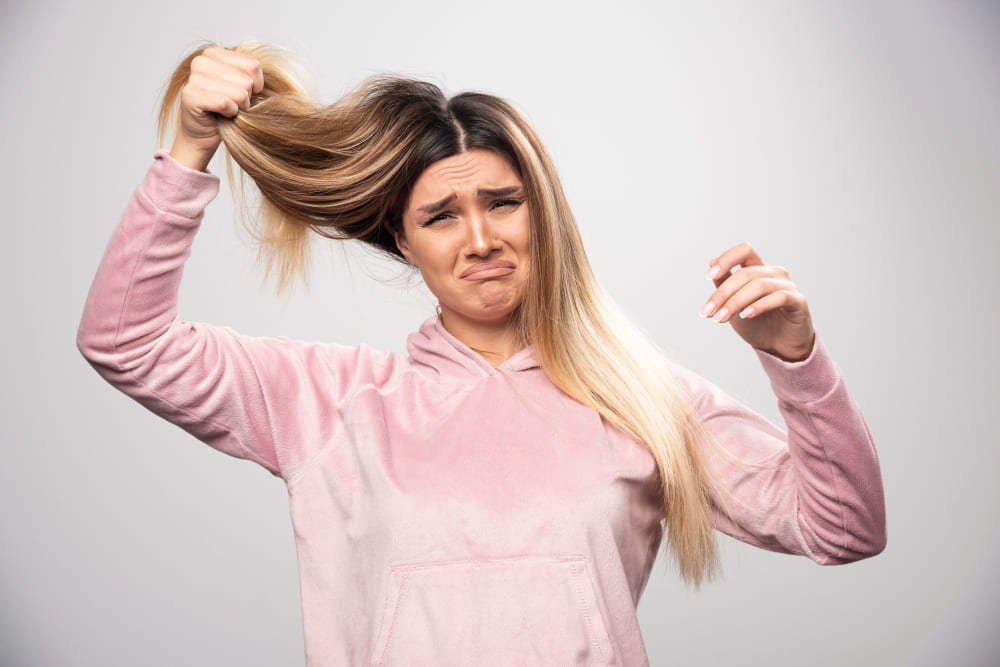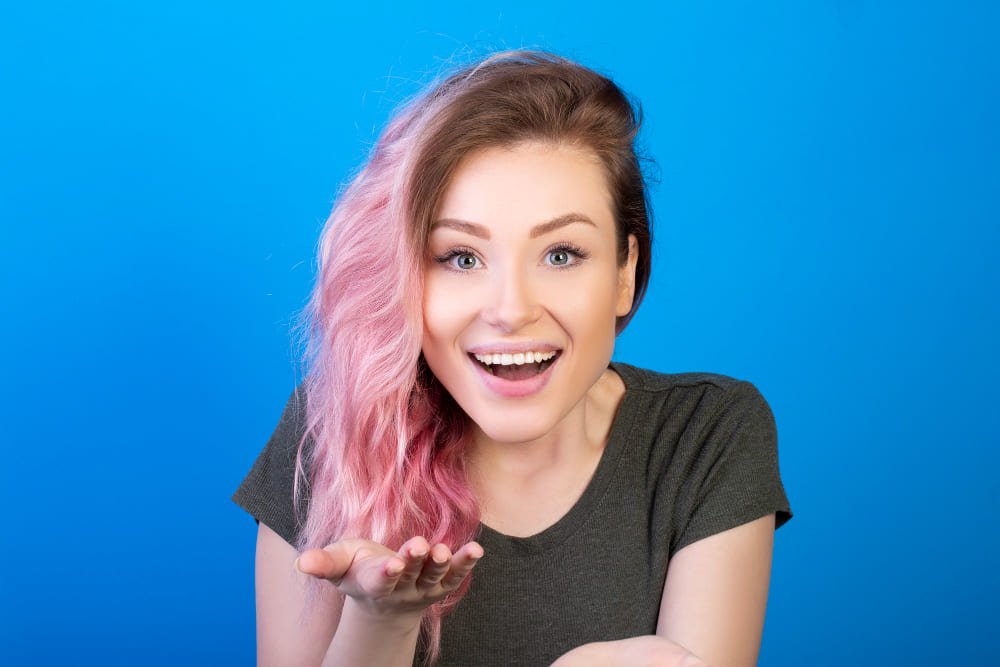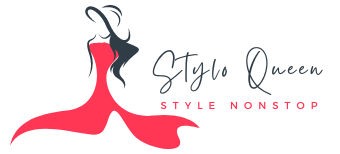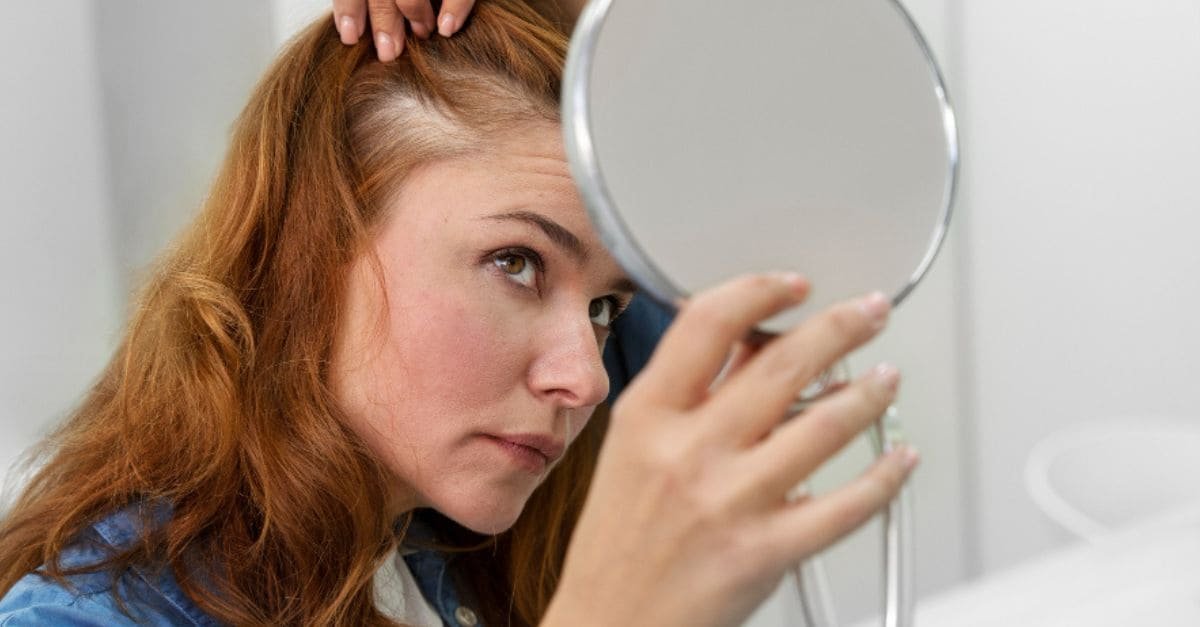Inside Article
Stop Hair Fall After Hair Colour
Hair coloring can be a fun and empowering way to express your personality and style, but it can also present challenges in the form of hair fall and damage. The frustration of seeing hair fall after hair colour can be not only disheartening but might also indicate deeper stress your hair might be undergoing due to the harsh chemicals in hair dyes, such as ammonia, peroxide, and PPD, which strip hair of its natural proteins and nutrients.
Understanding the root causes and implementing the right hair care strategies can help quell post-color hair fall and maintain luscious, touchable locks. Whether you’re a beauty hobbyist, an influencer, or someone who delights in vibrant locks, this guide is tailored to mitigate the dreaded hair fall while preserving the radiance of your colored hair.
The Science Behind Hair Fall After Hair Colour
Before we address the solutions, it’s essential to understand what might happen with your hair. Hair coloring causes a certain amount of damage because as the hair dye opens the hair cuticle to change color, the natural oils and proteins that protect hair are stripped away.
This process weakens hair strands, making them prone to breakage, and the absence of natural oils affects the hair’s elasticity, making it more likely to fall out. The cuticle damage leads to raised scales on the hair shaft, further aggravating the issue.
However, it’s important to note that not all hair colorants are equally damaging. Ammonia-free dyes and those with conditioning agents can result in less hair fall. Switching to gentler formulations or seeking professional colorists who use these can make a noticeable difference.
Prevention Methods for Hair Fall After Hair Colour
Deeply Condition Your Hair
Deep conditioning treatments should become a post-coloring habit. These treatments, such as masks enriched with keratin, coconut oil, or shea butter, offer intense nourishment and can help revitalize colored hair. Making this a weekly ritual can make a visible difference in the health of your hair.
Limit Heat Styling
Heat is your hair’s enemy, especially after coloring. Hair dryers, curling irons, and straighteners can be particularly damaging. Opt for air drying whenever possible; when heat is necessary, use a heat protectant to minimize damage.
Eat a Nutrient-Rich Diet
What you put in your body is as important as what you put on your body. A diet rich in proteins, iron, and biotin can promote healthy hair growth and maintain the strength of your colored hair. Foods like eggs, nuts, leafy greens, and salmon can benefit your tresses.
Natural Dyes for Healthier Hair

Tips for Caring for Colored Locks
Once you’ve colored your hair, your routine should adapt to protect and preserve the vibrant hues. Use color-safe shampoos and conditioners specifically formulated for dyed hair. They help maintain the color and the integrity of your strands.
Use Color-Safe Products
Color-safe hair products have a slightly acidic pH that helps to close the cuticle, locking in color. Additionally, they typically contain less harsh detergents, which can benefit hair already subjected to color processing.
Protect Your Strands from the Sun
UV rays can cause color to fade and hair to dry and brittle. Protect your locks from the sun with hats or hair products containing SPF. This helps with hair fall and ensures your color stays vibrant.
Regular Trims are Key
Scheduling regular trims every 6-8 weeks is crucial for maintaining the health of colored hair, as it cuts off any damage before it can travel up the hair shaft. This helps prevent breakage and hair fall.
Handle Your Hair with Care
Especially when it’s wet, your hair is more susceptible to damage. Use a wide-tooth comb to detangle and avoid rough towel drying or aggressive brushing that can cause breakage. Pat your hair dry instead of rubbing it to minimize damage.
Treat and Repair Damaged Hair
Post-coloring, treat your hair with reparative treatments. Look for products with ingredients that can nourish and repair, such as argan oil, avocado oil, honey, and shea butter.
Nourishing Oils and Conditioners
Incorporate natural oils like coconut, argan, or olive oil into your hair care routine. These oils can restore moisture and protect the hair shaft, which might reduce post-color hair fall.
Protein Treatments for Stronger Strands
Protein is what hair is made of, and replenishing it can strengthen your hair. Protein treatments can fill in damaged areas and defend against future damage, thus helping reduce hair fall.
Seek Professional Advice
If you’re experiencing significant hair fall after coloring, or if your hair is extremely damaged, seek the advice of a hair care professional. They can provide tailored treatment plans and recommend products for your specific needs.
Avoid Mistakes After Coloring
In the immediate aftermath of coloring, what you do—and don’t do—can make a big difference. Waiting 24-48 hours before washing your hair allows the color to set properly and minimizes the risk of wash-out.
Don’t Wash Your Hair Too Soon
Avoid the impulse to wash your hair immediately. Give the dye time to set and the scalp time to recover. You can even use dry shampoo to maintain a fresh look without compromising the color.
Say No to Hot Water
Hot water strips your hair of its natural oils. Stick to lukewarm or cool water when washing your colored hair, as it helps preserve the color and prevents dryness, which can lead to hair fall. After protecting your hair from the hot water you should also take steps to protect it from chlorine damage.
Limit Washing and Styling
Over-washing strips the hair, while over-styling can lead to breakage and hair fall. Find a balance that works for your hair, and use gentle techniques to style without causing stress.
Other Common Errors to Avoid
Be mindful of the products you use. Avoid those with harsh chemicals, like sulfates and alcohol, as they can further dry out your hair and cause breakage.
Home Remedies for Hair Fall After Hair Colour
If you’re into natural remedies, consider using ingredients like coconut milk and aloe vera for deep conditioning that can help strengthen hair and reduce hair fall. These ingredients are packed with nutrients and are gentle on the hair.
DIY Hair Masks for Nourished Strands

Steam Treatment for Deep Conditioning
Give your hair a steam treatment to provide deep conditioning and restore moisture. This can be done at home with a shower cap and a towel or at a salon with professional equipment.
By integrating these strategies and adjusting your hair care practices, hair fall post-coloring can be significantly reduced, if not eliminated. It’s all about providing the care and attention your hair needs to overcome the stresses it’s been through. Remember, healthy hair is beautiful, and with the right approach, you can have both, even after coloring.
Conclusion
Now you know that hair fall after coloring is a common issue, but it doesn’t have to be. By choosing natural dyes, using color-safe products, protecting your strands from the sun, scheduling regular trims and treatments, and following proper post-coloring care, you can minimize hair fall and maintain healthy colored locks. Don’t let the fear of hair fall stop you from experimenting with different hair colors and styles. With the right care, your colored hair can continue to look vibrant and beautiful for a long time. So go ahead and rock that new color! Remember these tips and tricks to reduce the impact of hair dye chemicals on your locks, and don’t be afraid to seek professional advice if needed.
How do you stop hair from falling out from dying it?
To prevent hair loss from dying your hair, here are some steps you can take:
Use a gentle, ammonia-free hair dye: Ammonia is known to damage the hair and scalp, so opt for dyes that do not contain this harsh chemical.
Follow the instructions carefully: Over-processing your hair with too much dye or leaving it on for too long can lead to damage and hair loss. Always follow the instructions on the dye box and don’t leave the product on for longer than recommended.
Deep condition regularly: Coloring your hair can dry it out, so it’s essential to keep it hydrated with deep conditioning treatments at least once a week.
Give your hair a break: Avoid dyeing your hair too often, and try to give it a break for a few months between coloring sessions.
Can hair loss from hair dye be reversed?
Unfortunately, hair loss caused by excessive hair dyeing cannot be reversed. However, taking steps to minimize further damage and promote healthy hair growth can help improve the overall appearance and health of your hair.
Why is my hair falling out after colouring?
Hair fall after coloring can be a result of several factors, including:
Chemical damage: The harsh chemicals in hair dye can cause damage to the hair follicles, leading to breakage and hair loss.
Over-processing: Coloring your hair too frequently or leaving the dye on for too long can over-process your hair, causing it to become weak and prone to falling out.
Allergic reactions: Some people may be allergic to the ingredients in hair dye, which can cause inflammation and damage to the scalp, leading to hair loss.
Nutritional deficiencies: A lack of essential nutrients in your diet can also contribute to hair loss. Make sure you are getting enough protein, vitamins, and minerals for healthy hair growth.
How do you stop severe hair fall fast?
If you are experiencing excessive hair fall, here are some tips to help stop it quickly:
Consult a doctor: If your hair fall is severe and sudden, it’s essential to seek medical advice from a dermatologist. They can diagnose any underlying issues and provide suitable treatment.
Use gentle products: Avoid using harsh chemicals or heat styling tools on your hair while trying to stop hair fall. Opt for gentle and natural products instead.
Massage your scalp: Massaging your scalp can help increase blood flow and promote hair growth. Use a nourishing oil like coconut or castor oil, and gently massage it into your scalp in circular motions.
Eat a balanced diet: Make sure you are consuming enough nutrients for healthy hair growth, including protein, iron, B vitamins, and vitamin D.
Reduce stress: Stress can contribute to hair fall, so finding ways to manage and reduce stress levels can help stop it quickly. Try practicing relaxation techniques like meditation or yoga.

